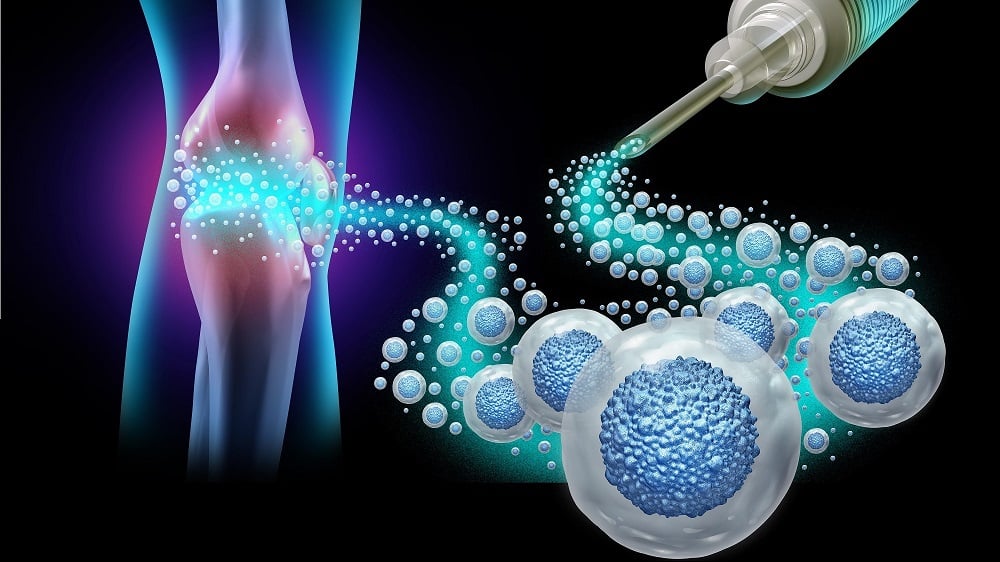A study in Pharmacological Research has found that small extracellular vesicles derived from embryonic stem cells (ESC-sEVs) alleviate osteoarthritis in cells and mice.
Restoring senescent cells’ function

Read More
Excessive senescent cell buildup in cartilage has negative effects and leads to osteoarthritis [1]. Constant exposure to SASP factors has been found to cause more cartilage to be removed than created by chondrocytes, the cells responsible for the maintenance of this extracellular matrix tissue [2].
However, simply killing off these senescent cells with senolytics might not be beneficial in people. We recently published a study finding that in the joints of rats, some senescent cells are necessary for encouraging nearby chrondrocytes to regrow tissue, and a previous senolytic approach to osteoarthritis did not make it through clinical trials.
This study uses a senotherapeutic approach, which seeks to rejuvenate senescent cells, rather than a senolytic one. Previous work has found that using extracellular vesicles derived from mesenchymal stem cells (MSC-EVs) might effectively treat osteoarthritis in this way [3]; however, that study was focused on a different kind of stem cell, and it was only used before senescence or in models of early osteoarthritis, which might be too late in a clinical setting. As ESC-sEVs have been found to be effective in repairing other tissues, including the heart [4], these researchers decided to apply them to models representing osteoarthritis in its later stages.
Testing with human cells
This study began by exposing human chondrocytes in vitro to the SASP factor IL-1β in order to drive them senescent, then administering ESC-sEVs to a treatment group of cells for a week. The cells successfully began uptaking the ESC-sEVs after 12 hours of exposure. The treatment worked: chrondrocytes exposed to ESC-sEVs had far lower levels of senescence according to the well-known SA-β-gal biomarker, almost to the levels of chrondrocytes not exposed to IL-1β at all. Similarly, markers of extracellular matrix production were restored by the treatment.
As previous work has found that the forkhead box O (FOXO) pathway is key to the cellular maintenance process known as autophagy, which has a significant effect on cartilage maintenance [5], these researchers tested the effects of ESC-EVs on FOXO-related gene expression. Here, too, the results were positive, although not for all genes: FoxO1A was upregulated, while FoxO3A was not. Other biomarkers confirmed that autophagy was being upregulated, while other testing proved that this pathway was the core reason why senescence was being reduced in these cells.
Effective in mice
In mice, a surgical procedure can be used to artificially induce long-lasting osteoarthritis. Eight weeks after this surgery was conducted, a treatment group had ESC-sEVs injected directly into the joint fluid for 12 weeks. While this treatment did not restore joint cartilage nor function to the levels of mice that only had a sham surgery, its effects were statistically significant, reducing widespread cellular senescence and regrowing substantial amounts of cartilage.
This treatment was also effective in naturally aged mice. While those mice did not have the complete destruction of cartilage that was brought about by surgery, they had substantial cartilage loss and other signs of osteoarthritis. Just like with the surgery-induced osteoarthritis, ESC-sEV treatment (from month 15 to month 24 of life) was able to reduce widespread senescence whiile restoring cartilage and function, although not to the levels of young (5-month-old) mice.
These findings, while they do not represent perfect restoration and need to be administered over long periods of time, are promising. While administering embryonic stem cells directly is unsafe, as it might lead to uncontrolled teratoma growth, the vesicles emitted by these cells apparently encourage cells to maintain their function. The available evidence suggests that cellular senescence is a balance that is harmed by aging, and if these results can be replicated in trials, this sort of approach can be confirmed to restore some of that balance.
Literature
[1] Xie, J., Wang, Y., Lu, L., Liu, L., Yu, X., & Pei, F. (2021). Cellular senescence in knee osteoarthritis: molecular mechanisms and therapeutic implications. Ageing research reviews, 70, 101413.
[2] Coryell, P. R., Diekman, B. O., & Loeser, R. F. (2021). Mechanisms and therapeutic implications of cellular senescence in osteoarthritis. Nature Reviews Rheumatology, 17(1), 47-57.
[3] Yin, B., Ni, J., Witherel, C. E., Yang, M., Burdick, J. A., Wen, C., & Wong, S. H. D. (2022). Harnessing tissue-derived extracellular vesicles for osteoarthritis theranostics. Theranostics, 12(1), 207.
[4] Khan, M., Nickoloff, E., Abramova, T., Johnson, J., Verma, S. K., Krishnamurthy, P., … & Kishore, R. (2015). Embryonic stem cell–derived exosomes promote endogenous repair mechanisms and enhance cardiac function following myocardial infarction. Circulation research, 117(1), 52-64.
[5] Akasaki, Y., Hasegawa, A., Saito, M., Asahara, H., Iwamoto, Y., & Lotz, M. K. (2014). Dysregulated FOXO transcription factors in articular cartilage in aging and osteoarthritis. Osteoarthritis and cartilage, 22(1), 162-170.







